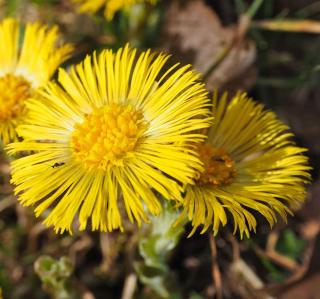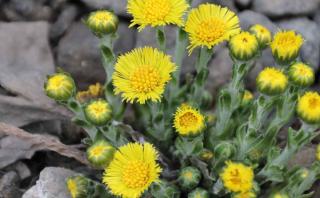

A herbaceous plant called “coltsfoot” or “horsefoot” in reference to the hoof-like shape of its leaves, coltsfoot grows in large colonies on steep slopes often prone to landslides, in moist terrain, and generally anywhere the soil has recently been turned over.
As it grows, coltsfoot tends to spread over any available surface with its ground-covering leaves that crowd out other species and inhibit their growth.
A rhizome perennial, coltsfoot is grown as a food plant, an ornamental decoration and also as a medicinal herb.
In the following lines, we’ll briefly address several topics relating to the benefits and properties of this plant. But the ones we’ll focus on are those that are beneficial to our health. What are these benefits? Which ailments does this plant treat? What are the prescribed usage and dosages?
Here is what you need to know…
The scientific name of this plant “tussilago” comes from the latin word “tussis” which means “cough” and “agere” which means “to hunt”. In short, the name’s root word can be translated by “that which sends away cough”.
This main property led it to also be called “coughwort” and “cough herb” and shows how it was most used traditionally.
It is part of the Asteraceae family, and coltsfoot is part of the top for most prescribed flower-bearing plants in Herbalism.
The growth of this plant is quite peculiar, because unlike other plants, it goes through two inverted growth phases: first the flower grows and wilts away, and once it has waned and died, the leaves appear.
For the past 2 millennia, this plant was heavily prescribed in traditional medicine as an antitussive on the European and Asian continents.
For a long time, therapists recommended that patients suffering from rhinopharyngitis, asthma or colds smoke the coltsfoot leaves much as they would tobacco.
Towards the end of the 18th century and the beginning of the 19th century, European practitioners attributed antibiotic and anti-inflammatory properties to this plant.
In China, where it grows in valleys and mountain ranges, coltsfoot flowers – famed for their expectorant and antitussive activity – were mixed with honey to treat cough.
But today, what is our stand on this exactly?

> zinc,
> vitamin C,
> 10% of natural phenolic compounds (tannin compounds) that can stimulate protein production,
> flavonoids which are an important source of antioxidants when part of our diets,
> about 8% mucilage which is a plant substance used as dietary supplements in the form of fiber,
> tussilagone (a sesquiterpene ester) and other compounds known to be poisonous due to pyrrolizidine alkaloids that have been identified in it.
As for the leaves, they contain:
– inulin,
– essential oil
– an antibiotic substance
– minerals (K, Mg, Ca, Si, Fe, P, Na, S)
– vitamin C,
– sap,
– tannin compounds
– 6 to 10% mucilage,
– potassium nitrate,
and lastly, toxic compounds among which, again, pyrrolizidine alkaloids.
Considered a replacement medicine for tobacco, coltsfoot can be smoked. Actually, once the leaves have been stacked and dried, it’s recommended to ferment the leaves of this perennial plant. After that, mix equal parts of this plant, sweetscented bedstraw leaves and horse chestnut leaves, and then macerate in honey-sweetened water.
When the maceration is over, dry the resulting blend and mix it to tobacco for smoking. This treatment is said to be prescribed to asthmatic persons and persons vulnerable to colds, catarrh and other pulmonary disorders.
Relying on coltsfoot leaves is common when treating respiratory disorders, for example colds, bronchitis, tracheitis, cough and allergic asthma attacks.
A definitive emollient, expectorant, antitussive and soothing agent, coltsfoot leaves and flowers are recommended in the form of syrup or infusions to soothes the aforementioned ailments.
When drunk in the form of base tincture, coltsfoot flowers are also effective to treat chest diseases and bronchitis.
Base tincture prepared from leaves, on the other hand, is recommended for ingestion to alleviate diarrhea.
When prepared as a poultice for topical use, coltsfoot leaves (macerated for an entire night in water, or used fresh) can treat burns, slow-healing abcess, tumors or externals cysts and sprains.

Quite effective to soothe chronic cough (without healing it though), drink a cup of coltsfoot leaf infusion in the morning upon awakening (when the cough is most intense) and then another dose in the evening before going to bed.
Depending on your situation, you can ingest up to 3 or 4 cups a day.
However, to alleviate the suffering due to foot hyperhidrosis, the correct preparation is to boil 1 handful of coltsfoot leaves in 1 quart (1 liter) water for 10 minutes. Let it cool, and when it’s cool enough, use the water as a footbath.
Note that in France and China, coltsfoot flowers are predominantly used, whereas in the United States, coltsfoot leaves are most used for their high content in active ingredients.
Coltsfoot flowers are edible cooked and raw (in mixed salads). Leaves are picked very young and eaten raw.
Sieved coltsfoot dried leaf ashes are actually used as a cooking spice and can replace salt, especially for persons who must follow a salt-free diet.
It’s recommended to collect and harvest coltsfoot flowers just as they bloom, because if picked too late, they already convert useful compounds to fruit formation during the drying, which isn’t a good thing. The drying must be quite rapid and be performed in a dry and ventilated spot.
A plant that grows along moist forest edges, atop mounds, along riversides, pathways, fields and in abandoned gardens, it contains senkirkine (a pyrrolizidine alkaloid) in very small amounts, but it is poisonous for hepatic cells.
According to specialists, this tiny amount is “without risk” to the body. However, it is preferable to avoid excessively concentrated treatments over a long span of time.
Nota Bene: Coltsfoot is not recommended for children under the age of six, for persons suffering of liver diseases and for pregnant women.
If in doubt, ask your consulting physician or a specialist for advice (herbalist).
I make a Coltsfoot tincture for my husband to treat his asthma and I blend it into a formula with Thyme, Mullein, Marshmallow, Nettle and Plantain. By that I mean his formula could contain all the other herbs in varying quantities depending on what I have, but he ALWAYS gets the Coltsfoot because without it his asthma returns. I have been a bit worried about his liver so I now include whole plant Dandelion tincture. Should I be worried? Is there anything else I can try in place of Coltsfoot? Many thanks x
Dear Terri, thanks for sharing. Good to know the asthma is under control. I’ve taken some time to research your questions a bit, sorry for the delayed answer.
> Should you be worried?
If your husband doesn’t have a previous history of liver disease or weakness, in short, you needn’t worry: a mostly healthy adult with a balanced food diet can break the pyrrolizidine alkaloids down before they do any damage. If, however, there are precedents like liver failure, cirrhosis or the like, it’s wise to try to shift to another plant, since most coltfoot courses are usually limited to 6 weeks.
> The more plants you can choose from, the better: convenience, availability, taste, higher balance…
As regards, asthma, there are quite a lot of plants that may help, like passion flower, dog rose, borage and more. This article may help you out! Where do you live? Perhaps there are also other, more local plants that are also potent.
> And don’t forget that modern medicine can help a lot, too: remember to consult your doctor if you notice anything out of the ordinary to have a formal opinion and course of action.